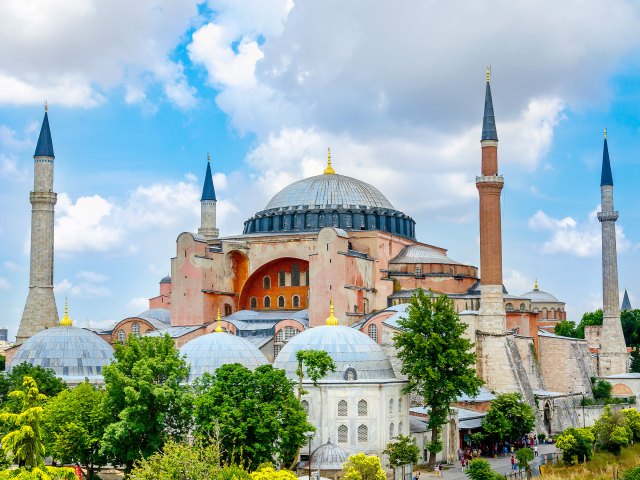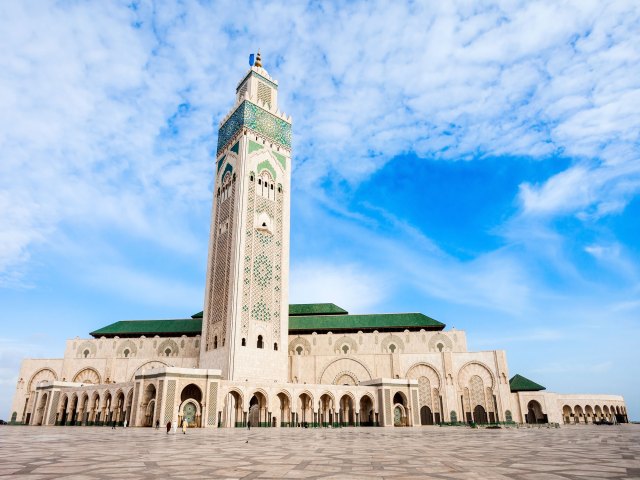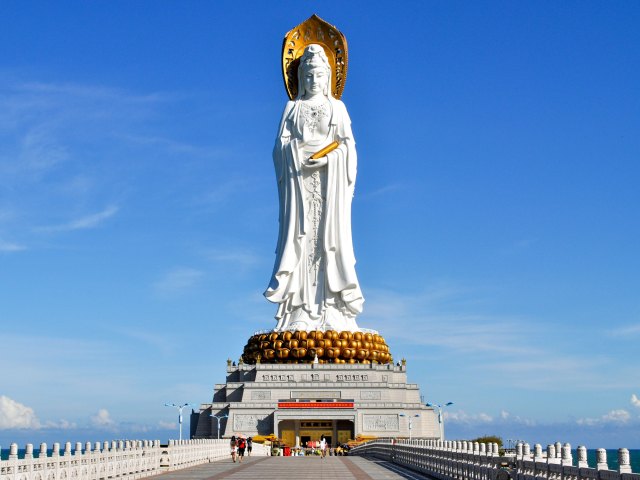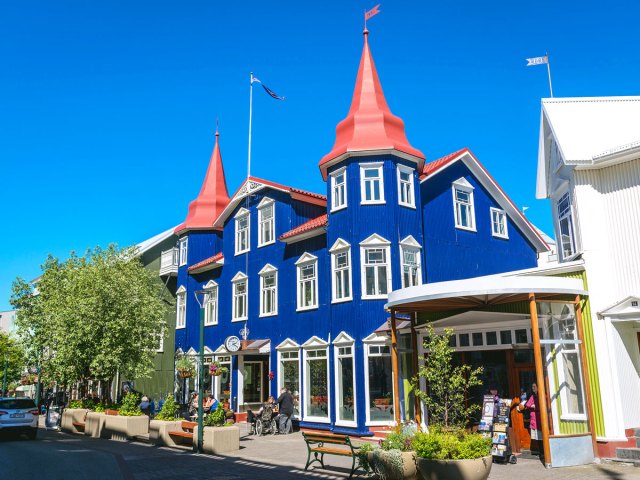Many religious monuments and places of worship around the world have one thing in common — bigger is better. From opulent European cathedrals to sprawling mosques in the Middle East and colossal gilded Buddha statues in Asia, these are 20 of the largest religious buildings in the world and the fascinating histories behind them.
Hagia Sophia – Istanbul, Turkey

Few religious buildings have lived such a fascinating history as Istanbul’s Hagia Sophia. This architectural wonder was first constructed by the Byzantines in the sixth century as a Christian church. When the Ottomans conquered Constantinople in 1453, they converted it into a mosque. In 1934 it was turned into a museum, and again a mosque in 2020.
The enormous building is arguably the finest known example of Byzantine architecture — inside are 104 columns brought from the Temple of Artemis in Greece, while outside, four minarets and a 108-foot-wide dome dominate the skyline of Istanbul’s Old City.
Dohány Street Synagogue – Budapest, Hungary

Tucked into the inner city district of the Pest side of Budapest is Europe’s largest synagogue. The Dohány Street Synagogue has a capacity of almost 3,000 worshipers and was designed by Austrian architect Ludwig Forster. The ornate building blends elements of the Moorish, Byzantine, Romantic, and Gothic styles — bright red and gold leaf geometric patterns beautify the lavish interior, as do a 5,000-pipe organ and a large rose window emblazoned with a Star of David.
Outside, twin 143-foot-tall polygonal towers topped with onion domes flank the entrance. The larger synagogue complex includes the fascinating Hungarian Jewish Museum and Archives, a Jewish cemetery, and the Raoul Wallenberg Holocaust Memorial Park.
St. Peter’s Basilica – Vatican City

The centerpiece of Vatican City, St. Peter’s Basilica is the world’s largest church building, after Basilica of Our Lady of Peace in Yamoussoukro, Côte d’Ivoire. Regarded as the holiest of all Roman Catholic shrines, said to be where St. Peter is buried, it can accommodate up to 20,000 worshippers at one time.
Construction of the cathedral began in 1506 and continued for 120 years. It features the work of esteemed artists and architects of the Renaissance, such as Bernini, Maderno, and Michelangelo. St. Peter’s Basilica stores several extraordinary art pieces, including Michelangelo’s Pietá, which portrays Mary holding Jesus after the Crucifixion. The basilica’s 138-foot-wide dome was a model for the domes at St. Paul’s Cathedral in London, and the United States Capitol in Washington, D.C.
Ulm Minster – Ulm, Germany

Ulm Minster may seem humble when compared with the other biggest church buildings in the world, but it holds one distinct honor: the world’s tallest steeple. The 528-foot-structure soars above the main entrance of the Gothic landmark and dominates the skyline of Ulm, a city in southern Germany. A 768-step staircase leads up through the steeple to a viewing platform, where visitors can see over the city’s medieval city rooftops, the Danube River, and the Alps in the distance.
Like many of Europe’s emblematic churches and cathedrals, Ulm Minster took several centuries — in this case, five — to complete. Work started in 1377 and was eventually finished in 1890. Incredibly, the church escaped undamaged during a World War II air raid.
Belz Great Synagogue – Jerusalem, Israel

Inaugurated in 2000 after 15 years of construction, the Belz Great Synagogue is the largest synagogue in Israel — or anywhere in the world. The grandiose central sanctuary can hold more than 6,000 worshippers. The massive scale of the synagogue was deliberate, built to replicate a synagogue located in the Ukrainian town of Belz that was destroyed during World War II.
Some say that the temple also bears resemblance to one built thousands of years ago by Herod the Great on Temple Mount, the holiest site in Judaism. The sanctuary of Belz Great Synagogue dazzles with nine chandeliers, each made with 200,000 pieces of Czech crystal, and features a wooden ark capable of holding up to 70 Torah scrolls.
Spring Temple Buddha – Lushan County, China

An imposing yet solemn figure against a backdrop of forest-clad hills in China’s Henan province, the 420-foot-tall Spring Temple Buddha is the world’s tallest religious statue. When the statue was built in 2008, after 11 years of construction, it was the world’s tallest statue overall, but India’s Statue of Unity overtook it in 2018.
The golden Spring Temple Buddha portrays Vairocana, the celestial Buddha, standing on a lotus flower throne. Below the main structure are two pedestals, which extend the landmark’s total height to 682 feet. Leading to the Buddha’s feet are two staircases, each divided into 12 flights of 365 steps to represent the months and days of the year.
Hassan II Mosque – Casablanca, Morocco

The most prominent landmark on Casablanca’s waterfront is the ornate Hassan II Mosque, completed in 1993. With capacity for more than 100,000 worshippers, it is the second-largest mosque in Africa. But perhaps more impressively, its 689-foot minaret is the one of the tallest on the planet, towering almost like a lighthouse over the Atlantic Ocean.
The impetus for construction of the mosque came from King Hassan II, who was concerned by Casablanca’s lack of historical monuments and desired a proper burial place for his predecessor on the throne, King Mohammed V, who died in 1961. The king employed thousands of artists and craftspeople to etch intricate designs on cedar wood and granite imported from all over Morocco. The seafront location is a reference to a verse in the Quran that says that Allah’s throne is above the water.
Milan Cathedral – Milan, Italy

Adorned with a collection of 135 spires, one of which stands a staggering 357 feet tall, Milan Cathedral (Duomo di Milano) is one of the world’s finest examples of Gothic architecture. The largest church in Italy and second-largest in Europe, it took more than 70 architects almost 600 years to erect this enduring landmark.
Construction began in 1386, using pink-hued marble extracted from quarries in nearby Candoglia and transported to the city via a network of purpose-built canals. The exterior of Milan Cathedral boasts a collection of 3,400 statues. Perched atop the tallest spire is the famous gold statue of Mary called the Madonnina.
Faisal Mosque – Islamabad, Pakistan

Despite being located in Pakistan’s capital city and considered the country’s national mosque, the Faisal Mosque was named after the late King Faisal bin Abdul-Aziz of Saudi Arabia, who funded the project. Constructed in 1976, the main hall, courtyard, and porticoes of the mosque can host around 300,000 worshippers.
While the size of this Muslim landmark is indeed notable, what’s even more striking is the modern, almost alien-like exterior design devoid of the traditional mosque dome. Instead, it resembles an inverted Bedouin tent and is flanked on all four corners by 260-foot-tall minarets. There’s even an urban myth that the CIA wanted to inspect the minarets because they believed them to be missiles.
Prophet’s Mosque – Medina, Saudi Arabia

The Prophet’s Mosque (also known as Al-Masjid al-Nabawi) holds immense religious and historical value for Muslims. According to Islamic scripture, the Prophet Muhammad himself built the mosque in 622 CE. Today’s building is a two-tiered rectangular structure that houses both the tomb of the prophet and an area on which his humble family home once stood. Decorating the flat roof of the mosque are 24 raised domes, which can be moved to create an additional prayer area during peak times. An estimated 1 million Muslim devotees visit the mosque for the annual pilgrimage.
Seville Cathedral – Seville, Spain

Covering a whopping 124,000 square feet, Seville Cathedral is a Gothic-style cathedral that stands on the site of a former mosque. Upon its completion in 1506, it overtook Istanbul’s Hagia Sophia as the world’s largest cathedral; today it is the third-largest cathedral in Europe. City leaders ordered the building of the cathedral (officially named Cathedral of Saint Mary of the See) to showcase the wealth of Seville that emerged after the Reconquista years and the expansion of Christianity throughout the Iberian Peninsula.
The cathedral features the impressive 343-foot-tall Giralda bell tower and a 66-foot-high altar piece, which is decorated with 45 wood panels that depict the life of Jesus and Mary. Seville Cathedral is also the final resting place of explorer Christopher Columbus.
Karnak Temples – Luxor, Egypt

Construction of the Karnak Temples began some 4,000 years ago, when Thebes, a city on the east bank of the Nile River where modern-day Luxor is located, was chosen as the site of the new Egyptian capital. Occupying more than 200 acres, the temples showcase the achievements of great Egyptian architects and rulers, such as Intef II, Hatshepsut, and Thutmose III.
One of the most impressive areas of the temples is the Great Hypostyle Hall, which has 134 columns, each 72 feet tall and carved with hieroglyphics. You may even recognize the hall from the James Bond movie The Spy Who Loved Me.
Great Mosque of Mecca – Mecca, Saudi Arabia

A visit to the Great Mosque of Mecca (aka Masjid Al-Haram) is also a rite of passage for many Muslims. A cube-shaped building at its center, the Kaaba, is the holiest shrine in Islam — on any given day, droves of worshippers come to visit it. Other significant areas of the Great Mosque are the sacred Zamzan Well, from which pilgrims drink holy water, and the Station of Abraham, a small square stone associated with the building of the Kaaba.
First recorded as a Muslim structure in 638 CE, the mosque has undergone several major renovations since the 1500s that were commissioned by caliphs, sultans, and Saudi rulers. At present, it is undergoing an expansion that will increase the capacity to over 2 million worshippers.
Cristo de la Concordia – Cochabamba, Bolivia

The Christ the Redeemer statue in Rio de Janeiro, Brazil, might be the more famous monument to Jesus, but neighboring Bolivia boasts one that is even bigger. Cristo de la Concordia lords 869 feet over the town of Cochabamba, and the statue itself is a symbolic 108 feet tall, which equates to 33 meters — one for every year of Jesus’s life. What gives Bolivia’s statue the edge over Rio’s revered Redeemer is an extra 1.5 feet of stylishly quaffed hair. Built between 1987 and 1994, Cristo de la Concordia is a popular tourist attraction accessible via cable car or a 1,250-step staircase.
Guanyin of Nanshan – Hainan, China

The celestial Guanyin of Nanshan statue rises 354 above a small island in the South China Sea, just off the coast of Sanya in the island province of Hainan. Accessible via a causeway, the whitewashed three-faceted statue depicts the Buddhist bodhisattva Guanyin, and each of the statue’s faces has an individual pose.
The Guanyin facing inland holds a sutra (Buddhist scripture) and makes the vitarka sign with her right hand, which symbolizes teaching, growth, and awakening. Two other deities face the sea, one holding prayer beads and another other with a lotus flower. The statue forms part of the Nanshan Temple, a complex home to replica temples from the Tang dynasty.
Jetavanaramaya – Anuradhapura, Sri Lanka

Jetavanaramaya is an ancient Buddhist stupa (a dome-shaped shrine for meditation) located within the ruins of the Jetavana monastery. When erected at the beginning of the fourth century, the 400-foot-tall stupa was among the world’s tallest structures — only two of the Pyramids of Giza were taller.
It’s no longer the tallest stupa, but with a base area covering more than 2.5 million square feet, it is the largest when measured by volume. An estimated 93 million bricks were used to build Jetavanaramaya, and the foundations are embedded 28 feet into the ground. The stupa belongs to one of the Buddhism world’s most significant shrines and can house an estimated 10,000 monks.
Kesaria Stupa – Bihar, India

Located amidst tranquil surroundings in northeastern India and partly overgrown by vegetation, this multitiered Buddhist monument is also one of the largest stupas in the world, rising 104 feet tall with a circumference of approximately 400 feet. The original structure dates back to the third century BCE, although what is seen today was likely built between 200 and 750 CE.
Kesaria Stupa is closely associated with the final days of Buddha, who had announced his attainment of nirvana upon departing from Vaishali for Kesaria. The Licchavi clan followed Buddha to the town and erected the stupa in his memory. Excavations in 1998 uncovered arrowheads, Islamic coins, and ruined idols, among other artifacts.
Sri Ranganathaswamy – Tamil Nadu, India

Sri Ranganathaswamy is the largest Hindu temple in India, covering 156 acres in Tiruchirappalli, a city in the Indian state of Tamil Nadu. The temple is dedicated to Lord Ranganatha and is considered the holiest of the 108 Divya Desams (Vishnu temples) mentioned in an ancient collection of Tamil verses.
The architecture is classic Dravidian, which is a colorful style that originated in South India. The sprawling complex also features 21 ornamental gopurams (tower gateways), the tallest of which is 240 feet. Each December, hundreds of thousands of pilgrims attend the 21-day Vaikunta Ekadasi festival at the site.
Borobudur Temple – Magelang, Indonesia

Set on a majestic hill and surrounded by lush jungle is Borobudur Temple, which lays claim to being the largest Buddhist temple ever built. This UNESCO World Heritage Site took 75 years to construct and was unveiled in 825 CE. It has a surface area of approximately 26,000 square feet and is designed in three tiers: a pyramidal base, a core of three circular platforms, and a crowning stupa.
Other notable aspects are a collection of 72 smaller stupas and over 2,500 bas reliefs. Borobudur was abandoned and overgrown with jungle sometime between the 10th and 15th centuries, but it was rediscovered in the 19th century by Thomas Stamford Raffles, the British ruler of Java at the time, and restored in the 1970s.
Angkor Wat Temple – Siem Reap, Cambodia

Sprawling across a vast area of over 400 acres in northern Cambodia, the Angkor Wat temple complex is the world’s largest religious structure. Erected by the Khmer Empire in the 12th century, this awe-inspiring monument began as a Hindu temple and was later converted into a Buddhist place of worship.
The temple design is an architectural portrayal of Mount Meru, which is the center of the Hindu universe. The five towers represent the five peaks of the mountain, and the surrounding moat and defensive wall symbolize the oceans and mountain ranges. How colossal is Angkor Wat? It’s so large that many of its features are visible from space.
More from our network
Daily Passport is part of Optimism, which publishes content that uplifts, informs, and inspires.























